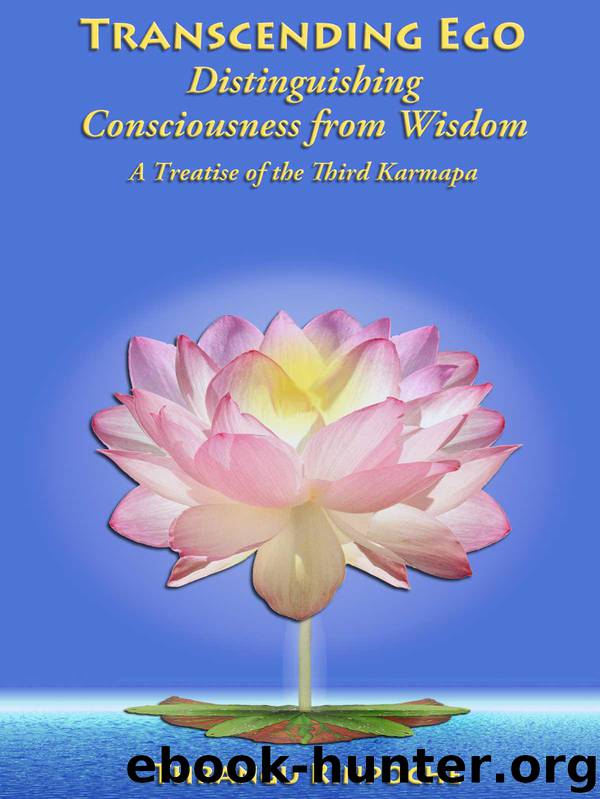Transcending Ego: Distinguishing Consciousness from Wisdom by Thrangu Rinpoche Khenchen

Author:Thrangu Rinpoche, Khenchen [Thrangu Rinpoche, Khenchen]
Language: eng
Format: epub
Publisher: Namo Buddha Publications
Published: 2013-10-11T16:00:00+00:00
PART II
THE FIVE WISDOMS
Chapter 5:
The Transformation of the
Consciousnesses into the Wisdoms
THE FIVE WISDOMS AND THE THREE KAYAS
Jamgon Kongtrul has written a commentary on this text called The Adornment of Rangjung Dorje’s View . At this point Jamgon Kongtrul has added information on how the five aggregates are transformed into wisdoms at the time of buddhahood. Although this does not appear in Rangjung Dorje’s treatise, it will be helpful to discuss it here.
The five aggregates (Skt. skandhas ) literally mean “heaps” and are form, sensation, perception, formation, and consciousness. Each of these aggregates is transformed upon reaching enlightenment. The aggregate of sensation (which includes within itself the three kinds of suffering: the suffering of suffering, the suffering of change, and the all-pervasive suffering) transforms into freedom from suffering as well as an unbroken continuity of great bliss. The aggregate of perception is transformed into the unhindered ability to teach the Dharma. The aggregate of formation is transformed into miraculous deeds and the gathering of Dharma students. Finally, the aggregates of consciousnesses are transformed into the five wisdoms. As may be seen it is the sixth, mental consciousness that is the aspect of mind that becomes the wisdoms at the level of enlightenment.
Jamgon Kongtrul describes four causes within the practice of the path of Dharma that give rise to four of the five wisdoms. Hearing and contemplating the full range of the Buddha’s teachings in the Tripitaka (the Vinaya, the Sutras, and the Abhidharma) will cause “mirror-like wisdom” to develop. Engaging in the meditation of helping all sentient beings without any partiality to friends or aversion to enemies will cause the “wisdom of equality.” The giving of Dharma teachings with the motivation of love and compassion and a desire to help all sentient beings will cause “discriminating wisdom” to develop. Finally, the accomplishing of activities to benefit others is the cause for “all-accomplishing wisdom.” We could add that the realization of the true nature of phenomena is the cause for the fifth, “dharmadhatu wisdom.”
There are three realms (Skt. kayas ). There is the dharmakaya , which is the pure realm of complete enlightenment. This manifests as the sambhogakaya , which is a pure realm where only realized beings (bodhisattvas and buddhas) can visit and receive teachings. Finally, there is the nirmanakaya , which is our earthly realm, inhabited by beings in samsara.
By diligently listening to and contemplating the Dharma and meditating on it, we are able to slowly eliminate the disturbing emotions and gradually develop the wisdom of the true nature of phenomena. We progress through the ten bodhisattva levels terminating in the attainment of buddhahood. At this point we have completely eliminated the causes of samsara: negative karma and the disturbing emotions. Our suffering is replaced with the experience of great bliss and peace. This is the first benefit of buddhahood, which principally liberates oneself. Upon attaining buddhahood we also eliminate all obstacles to our wisdom and attain perfect realization, or “omniscience.” This benefits others because with this knowledge we can show them how they too can attain buddhahood.
Download
This site does not store any files on its server. We only index and link to content provided by other sites. Please contact the content providers to delete copyright contents if any and email us, we'll remove relevant links or contents immediately.
| Anthropology | Archaeology |
| Philosophy | Politics & Government |
| Social Sciences | Sociology |
| Women's Studies |
Welcoming the Unwelcome by Pema Chodron(618)
Bardo or Not Bardo by Antoine Volodine(546)
Dzogchen by The Dalai Lama(529)
Taming the Tiger Within by Thich Nhat Hanh & Pritam Singh(485)
A Step Away from Paradise: The True Story of a Tibetan Lama's Journey to a Land of Immortality by Shor Thomas(481)
The Six Perfections by Lama Zopa Rinpoche(472)
The Tibetan Book of the Dead by Dorje Gyurme & Coleman Graham(466)
0307731871 (N) by Elizabeth Esther(463)
Awaken Every Day by Thubten Chodron(455)
A Guided Tour of Hell by Samuel Bercholz(443)
The Compassion Book by Pema Chodron(440)
A Death on Diamond Mountain: A True Story of Obsession, Madness, and the Path to Enlightenment by Scott Carney(417)
A Direct Path to the Buddha Within by Klaus-Dieter Mathes(411)
Pointing Out the Great Way: The Stages of Meditation in the Mahamudra Tradition by Brown Ph.D. Daniel & Robert Thurman(405)
The Psychedelic Experience by Leary-Alpert-Metzner(379)
The Heart of Unconditional Love by Tulku Thondup(360)
Wisdom Energy: Basic Buddhist Teachings by Jonathan Landaw & Lama Yeshe & Lama Zopa Rinpoche(353)
Buddhist Magic by Sam Van Schaik(350)
Magic and Mystery in Tibet by Alexandra David-Neel(348)
